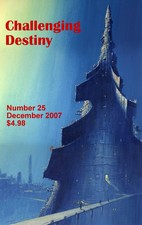


Reviews Home
Columns
Fiction by Title
Fiction by Author
Nonfiction
Movies by Title
Movies by Rating
Audio
Games
The Meek, Scott Mackay, Roc, 2001, 328 pp.
The Meek is one of the most lucidly written science fiction novels I've read in a long time. Mackay's prose is elegant in its efficiency -- this novel conveys exposition in the sleekest manner imaginable -- yet the writing is also worthy in its own right. What's more, Mackay has a remarkable degree of control over the structure of the novel and its effect on the reader, a matter that I will be discussing at length later in the review. The Meek is a notable achievement that seems to play to entirely different strengths than Mackay's previous novel, Outpost.
The Meek begins with a man named Cody Wisner, a Public Works official and engineer, as the task force Cody is in charge of approaches the asteroid Ceres. Cody and his team are from Vesta City, a habitat on an asteroid not big enough to sustain gravitational energies close enough to one gee to avoid certain low grav illnesses and deficiencies. Ceres is large enough but needs to be re-inspected and refitted for habitation 30 years after war, a war in which altered humans known as the Meek were subject to bioextermination. The book begins as Cody detects anomalies on the surface of Ceres, and most of the background exposition is conveyed gracefully in the first three or four chapters. It seems that the Meek were not wiped out and have their own plans for Ceres.
Part 1 of the book deals with first contact, as Cody and his team land on the asteroid, meet the Meek, and struggle for survival as the Meek demonstrate their superiority. Cody befriends a Meek named Lulu and she becomes a reluctant liaison between the two groups as the story progresses. Part 2 of the book tells of the political consequences of contact. Vesta City sends a military spaceship, captained by a man named Kevin Axworthy, coincidentally the son of the scientist who created the Meek. The conflict becomes more serious, due to gravitational control technology in the hands of the Meek and the threat it represents the other humans. Cody learns more about the opposing plans for Ceres, and this sets the stage for the final part of the book.
This is where the book takes on a peculiar structure. I'm discussing the final third of the book, so a spoiler warning is in effect. Essentially, Cody discovers that the Meek's plans are peaceful: they are using Ceres to modify the trajectory of a rogue planet incoming through the solar system and also to transfer themselves to this planet on its way out. Successful transfer to the new planet seems like a natural endpoint for the story. However, Mackay continues for another eight chapters, with a whole new story arc with its own struggle and resolution. The rogue planet, named Carswell, is inhabited, and the inhabitants prove to be a dire threat to the existence of the Meek, who seriously consider various final solutions. The apparently broken-backed structure of the book reminds me of 2001 (which had more than one break) or, further afield from science fiction, Vertigo. Both The Meek and Vertigo resolve all of the initial questions partway through their story, and go on to become something quite different. At first glance, neither The Meek nor Vertigo seem to work, but a longer view show that genre expectations (mystery and science fiction respectively) are being manipulated. It takes a deft hand to pull off this trick, to pull the reader past initial disappointment into an understanding of the implications of the structure. Hitchcock was up to the task, but is Mackay?
Interestingly, I find it hard to say. And I need to make another comparison to explain my ambivalence. The Meek reminds me a great deal of two books by Elie Wiesel. Wiesel's famous short novel Night is a brutal and direct account of a young boy's experience in the Nazi death camps. Wiesel also wrote a book called Dawn, in which a young Israeli soldier is ordered to execute an enemy officer at dawn. With no disrespect meant to Wiesel or the Holocaust, Night resembles Parts 1 and 2 of The Meek, with a particular group under threat of extermination (or the reality thereof) due to their identity. Dawn and Part 3 of The Meek tell the story of that same group turning around and becoming oppressors. Both of the Wiesel books are intensely written and perfectly formed on their own, and Mackay tries to combine the two story arcs, perhaps clumsily, in one book. My ambivalence comes from the fact that Wiesel recognized the importance of the connection between the two stories and collected them in the Night Trilogy (along with The Accident, an excellent short novel about survivor's guilt). The story of the Meek does not end with their triumphant arrival on Carswell, free from the shackles of the evil humans. Categories based on identity break down and the story becomes universal. Every choice on every day has to be considered in terms of its moral consequences. This is what I see in the construction of the storyline of The Meek. Mackay tries to pull off an ambitious feat here, and I grow to like the book more and more as I think about it. The first reading of the book is a much different experience than the second.
Last modified: July 31, 2001
Copyright © 2000 by James Schellenberg (james@jschellenberg.com)

Buy back issues of Challenging Destiny online from:
For the latest information on availability: Where Can You Buy Challenging Destiny?